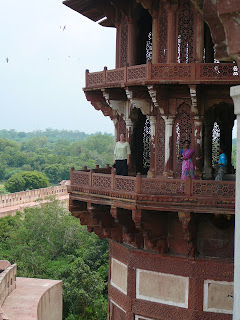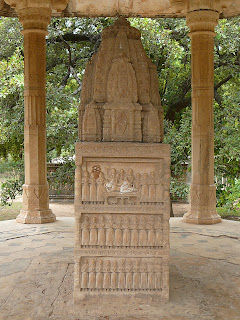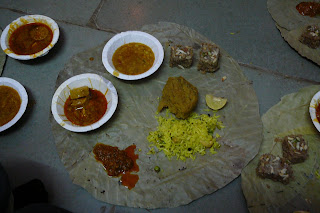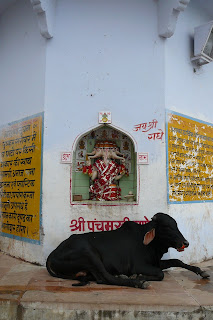
The Taj Mahal
Ever since we started planning our big trip, we've sort of considered India to be the Main Event. That's not to say that India would be the end of our trip, but instead it would be the part of the trip that would challenge us the most and also hopefully be the most fulfilling. And, if India was the Main Event, then the Taj Mahal would basically serve as the Grand Finale of the Main Event. To this end, Sarah and I had deliberately put off going to Agra until the end of our India leg. That way, if nothing else, we knew we'd be ending this leg of our journey on a high note.
The first time we caught a glimpse of the Taj was walking across the bridge entrance of the Agra Fort. I just happened to glance to my left, and noticed a number of white onion-shaped objects rising above the distant tree.
"Oooh, oooh, Sarah! Come look! See what I see!"
A short time later, as we continued to explore the Fort, we found ourselves on a massive deck that looked across the river to the Taj Mahal. It's amazing really, on this trip we've been fortunate enough to see a number of world famous sites. Macchu Pichu. Easter Island. Angkor Wat. So, you'd think that at this point, we'd be getting a bit numb to these sort of experiences. But, those first glipses of the Taj still stunned me as I looked across the river at it - slightly blue in the mist and atmosphere, looking more like a matte-painting than a work of architecture.
 At this point, we've seen it, but it still doesn't seem real.
At this point, we've seen it, but it still doesn't seem real.But, that's not to take away from the Fort itself. Agra Fort is one of those locations that could otherwise captivate you... its just that it has the misfortune of sitting in the (nearly literal) shadow of the Taj Mahal. With its massive walls, ornate marble-work and expansive courtyards, it took Sarah and I the better part of our first day in Agra to explore all of it.
 A courtyard in the Fort. The size and detail of the place is amazing.
A courtyard in the Fort. The size and detail of the place is amazing. Sarah poses on a turret in the fort. The small kids next to her would later ask to have their picture taken with her.
Sarah poses on a turret in the fort. The small kids next to her would later ask to have their picture taken with her.Later that day though, our auto-rickshaw driver (more on him below) took us to a spot on the far side of the river to look across at the Taj from there.
As we approached the river, a group of small children approached us (one carrying a baby goat), and began asking us our names and where we are from. Having been in India for a month now, Sarah and I are used to this. Not just children, but adults too, will approach us and inevitably hit us with the same flurry of questions:
What is your name? What is your friends name? Where are you from? What is your occupation? How long have you been in India? How to do you like it here?
It is almost always the exact same set of questions. And, after anwsering them a dozen times a day for the last 30 days, let's just say that they get a little tedious. So, Sarah and I have come up with aliases. I'm now Rupert, and she is Belinda. We're from Sweden. And I'm a secret agent.
Oddly, these anwsers elicit the exact same responses that we get when we use our actual, factual information. So apparently, in India, being "someone who works on the Internet" is just as maginally interesting as being "a secret agent, like James Bond."
Having introduced ourselves (or at least introduce Rupert and Belinda) to the children, and assuring them that we had no intention of paying them for ther pictures, the children (and their goat) ran off to find other tourists to quiz. Letting us get back to staring at the Taj Mahal.
Now, we've run into several people who have been to Agra and only looked at the Taj from the view across the river, and said that it was all they needed to do. Their argument is that the entrance cost to the Taj itself is too high. And, while I agree 750 Rupees (about $18 US) is a lot, comparatively; Sarah and I also knew that we had to go in. I mean, we've payed thousands of dollars to get to this point. To stop and only see it from across the river seemed a little goofy. Like climbing Everest, stopping 100 meters shy of the summitt, and going "y'know, the views good enough from here, I'm going back down."
So, the next day, we got up bright and early (as I've mentioned before, that's become a bit fo a challenge for us) and made our way to the entrance of the Taj Mahal. After paying the entrance fee (and checking our tiny, tiny camera tripod at the door, because -rather randomly- they aren't permitted inside), we made our way into the Taj Mahal complex.
Now, I've noted before that its easier to write complains than it is to write praise, so instead of straining to find interesting adjectives that mean "wonderous" I'll just post a few photos and make a few points.
 A close up of the level of detail on the outside. Since most photos are from farther away, you don't realize how much color and detail is featured on the marble work.
A close up of the level of detail on the outside. Since most photos are from farther away, you don't realize how much color and detail is featured on the marble work.First off, if you do go, go in the morning. When we first arrived, the crowds were reasonable. But, as we prepared to leave a couple hours later, the crowds were beginning to swell. Luckily, the complex is large enough and the architecture is grand enough that you tend to not notice the sunburnt masses swirling around you, but still.
 One of several "Look! We were really there!" photos we took.
One of several "Look! We were really there!" photos we took. Also, the sound inside the Taj Mahal is incredible. Its something we've never heard anyone talk about before, but its truly unique sounding. The main tomb portion of the Taj has (as you might suspect) a giant dome, marble ceiling. Inside, everyone does their best to be quiet, but the acoustics are such that every little whisper and shuffle travels to the top and echos around in such as way that the entire room is filled with this low, hollow, roaring groan. It's a dry, omnipresent, yet oddly-peaceful sound ...and its amazing.
The Trains of India
So, we took the train from Bundi to Agra. As Sarah mentioned in another entry, we've become accustom to riding buses in India, but at the same time, we realized that no trip through India is complete without a train ride. So, we scheduled a ride on an overnight train from Bundi to Agra.
First off, the train tickets in India are basically useless. They contain a bunch of information, but don't contain any information you might actually need. Like, the train number. Or what car your on. Or what platform you need to catch them at. In addition, the station generally has no one available to help you sort out these facts, so you are basically left in the position of hoping on a train and hoping that its your train. Also, there appears to be no one actually checking tickets on the train, which means you still aren't sure your on the right train when it pulls away from the station... and leaves you wondering why you even spent the money on the useless ticket in the first place.
Once on the train, we found what we thought were our seats, but they were filled with two sleeping elderly men, so we just grabbed other seats at rondom. This worked fine, until we reached the next major station, and people started demanding their seats (which we'd inadvertently taken). At this point, some nice fellow -who may or may not have been a station attendant- took pity in us and directed us to another random car and told us our assigned seat numbers (which seemed to have no relationship to the seat numbers listed on the tickets).
The train then started moving again, but started heading back the way we came. Which caused a moment of panic until I asked someone who assured me that the train was going to Agra... and not back to Bundi.
We had tickets for "sleeper" seats, which we presumed meant that we would be sharing a bunk-bed cabin with two other people. But, in reality, it meant that we were each sharing a bench with two other people. When it came time to sleep, these benches converted into three-bed-high bunkbeds. The main problem with this was that it allowed some of the people around us to play the game "Watch the Sleeping Tourists." We've grown used to the fact that everywhere we go people are staring at us... still, its a little unsettling to have people watch you try to fall to sleep.
The train ride from Bundi to Agra did nothing to prepare us for our second train ride though: Agra to Dehli.
The second class train tickets we got for this ride claimed that the trani would be "Super Fast™" ...but failed to mention that it would also be "Super Crowded™." Crowded train rides in India are one of those things that travellers hear horror stories about. But, which nothing can prepare you for the reality of. So, let me break it down for you.
First off, the train arrive (or what you presume is your train) and a crowd starts to mill around outside the train car doors. When the doors open, you realize that the car is already full of people, but that doesn't make any difference to the crowd outside which imediately begins pressing itself into the car. Like our bus ride from Pushkar to Ajmer, just getting on the train is a battle. The melee is not disimilar to a group of sugar-charged children bum-rushing a broken pinata.
Like Sarah mentioned in her description of boarding the bus, the main tactic involves merciless pressing yourself forward, until you reach the point of no return that suddenly the people behind you start pushing you into the train car.
Once inside, Sarah and I have a unique problem, in that we both have massive bags. Inside the train, there is barely enough room left to stand (and no apparent room for luggage), so we both slid our bags off and planned on sitting on them. At the same time, we've noticed that there is one large Alpha-Male type guy who is reclining on one of the top bunks, taking the whole thing for himself. As the crowd continues to press in around us, Sarah and I begin flashing him evil looks until suddenly he sits up and invites us to sit next to him. We aren't sure if its because of our Mean Faces™ or because he's decided it would be fun to sit next to tourists, but we quickly take him up on his offer regardless.
Now, the train car is divided into a number of subsections. Each subsection is made up of a top and bottom bunk bench, facing another set of benches. On one top bunk is me, Sarah, the Alpha-Male and a middle aged woman (who climbs on at the next stop and proceeds to take the majority of the bench for herself). Across from us is (what I presume is) train attendant, what I guessed was his brother, two other men and a small girl who is so squeezed in that we can hardless see her head peaking out over their shoulders. Most of us have taken our shoes and sandals off and have placed them on the fans on the ceiling above us, so that we don't accidently kick those elow us with them. Below us is a half dozen other people, and across from them another half dozen. Between those people there are three or four young boys who are standing, and catching my Rupees that keep falling out of my pocket onto their heads.
It's a tight fit to say the least. And, after three or four hours squished into those positions, we are happy to be in Agra... and off the train.
Which is where we meet our auto-rickshaw driver.
The trouble with auto-rickshaw drivers
I would say that a good 60% of the problems we've had in India stem from our dealings with auto-rickshaw drivers. They're obnoxious... really, they are. As I think I mentioned elsewhere, dealing with auto-rickshaw drivers is like being stuck in a bad relationship with a really, really needy and clingy partner. I'm going to describe how our "relationship" with our rickshaw driver in Agra went. It is by no means atypical of what we've experienced with other drivers.
As we exited the station, we are approached by a middle aged man. "Need rickshaw driver?" He asks.
"Yes, actually. Do you know the Tourist Rest House?"
Surprisingly he anwsers "yes."
"How much to get us there?"
"30 Rupees." Which is reasonable. So, we accept. He leads us out to a rickshaw which -like many we've ridden on- barely starts. There's another guy who is actually driving it, and his job seems to be to sit and talk to us while we are riding.
"If you like, we can come back in a couple hours. After you shower, rest and eat, and then take you out to the sites. Taj Mahal is closed today. But we take you to Fort. To Baby Taj. To other tombs. Take you to river. You can see Taj from across."
"How much?"
"200 Rupees. It is slow season, so we give you good deal."
Arriving at the guesthouse, I finalize plans with him.
"So, for 200 Rupees, you'll take us to the sights."
"Yes."
"And we choose where to go. No shops, right?"
Slight smile. "As you wish."
"OK, pick us up at 1pm."
So, 1pm comes, and the two men are waiting outside the hotel with their rickshaw. At first, things go well. They take us to the Fort, which is amazing. And the "Baby Taj," which would have been amazing if we weren't hounded by a flock of children shouting "take our picture one rupee!" Then another tomb, befoe eventually taking us to the river to see the Taj.
 The "Baby Taj." So named because it looks like the Taj Mahal... except smaller. It actually pre-dates the Taj Mahal.
The "Baby Taj." So named because it looks like the Taj Mahal... except smaller. It actually pre-dates the Taj Mahal.But, slowly, he starts mentioning taking us to "factories," which is rickshaw driver shorthand for "shops."
"Maybe we take you to factory to see how marble is made. And one for rugs. Very interesting."
"No, we don't want to go to any shops."
"But, these are more like workshops. See how they are made." Generally, in these workshops, a disinterested employee gives a 3 minute demonstration on how to do something, before you spend the next hour or so trying to convince them you have no interest in buying their item.
"No. No shops. No workshops. We don't want to buy."
"But, it is interesting. Here is only place in India where you can see this sort of marble work done. And rugs made..."
"No. We've already seen rugs made."
"But, is interesting. It is experience..." Rickshaw drivers like to try to make going to shops seem like an experience on par with seeing temples or forts. "Maybe you take picture."
"No. They'll try to make us buy something."
"No pressure to buy. It will be very quick. You just take picture and then leave. You will have picture for memory."
"No we don't want a picture. And we don't want to see how marble is made. Or rugs are made."
This sent him into a sullen pouting session for the next couple of sites. After looking at the river and Taj, Sarah and I were ready to go home.
"It is still early, maybe go to a workshop very quickly."
"No. We are tired and want to just go back to our room. So, take us home, and we can pay you for the day."
"But, you must undestand. 200 Rupees is not very much money. That barely pays for the driver. And his gas." He says gesturing to the always silent driver. "We need money to survive. Shops will give us money to bring you. Comission."
"We know how it works. I'm sorry, but no. You agree that the amount was 200 Rupees, and no shops. You said 'as you wish.' If that wasn't enough money, you should have said. We would have been willing to pay more, if you had requested more. We would have paid more, to not go to shops. If you had been honest. But you chose to lie. That's not a good way to do business. So, no."
OK, no I might seem like a bit of a moralizing jerk here. But, still. I mean, they do this to us every time. A short while later...
"So, tomorrow, I pick you up at guesthouse and take you to Taj. Maybe afterward, we go to shop."
"No. In fact, don't plan on picking us up tomorrow. We will make other arrangement."
More pouting.
Then, as we get off the rickshaw I turn to pay him. I hand him 300 Rupees. He looks at it.
"It was 200 Rupees for tour. And 30 for ride from train station. That money is for driver. What about for me?" He seems to be ignoring the additional 70 Rupees.
"What did you even do?!" We storm off flabbergasted. That evening, we had a pleasant meal on a rooftop restaurant overlooking the Taj. Around us, hundreds of people mysteriously were flying kites, the city sky filled with them. Sadly, as Sarah can tell you, all I could do was mumble and grumble about rickshaw drivers.
 Our view that evening for dinner (notice the kite in the foreground)...
Our view that evening for dinner (notice the kite in the foreground)... ...but here's the type of face Sarah had to see me make.
...but here's the type of face Sarah had to see me make.Now, go back and read the first part of my entry. Because the Taj Mahal was really fantastic. And, it'll help end this blog entry on a good note.
We also have some good news and stories involving Delhi (and one piece of bad news)... but I'll save those fo a future entry. This ones run too long.










































